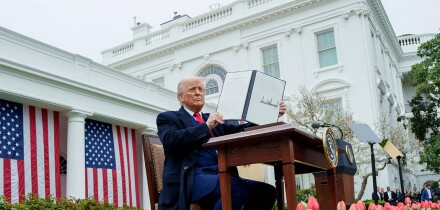Introduction
The zero-cost collar is a time-honored risk management vehicle composed of a long put option and short call option of the same maturity and equal premium. The long put option reduces the investor's risk of loss in the underlying equity while the short call option limits the investor's upside in the stock. Typically, when structuring an over-the-counter zero-cost collar, the put strike is first set and then the call strike is set at such a level that the put and call options have offsetting costs.
Since an investor's upside is capped by the short call, a higher call strike is preferable (other things equal) to a lower one. Thus, it is useful to isolate the factors that influence the level of the call strike. Five principle factors impact the level of the call strike: the put strike, the time to expiration, the interest rate, the dividend yield, and the volatility.
The Effect of the Put Strike
The investor uses the put option in a zero-cost collar to reduce the risk of loss in an equity position. The higher the put strike, the more insurance provided by the put, and as a result, the lower must be the call strike in order for the collar to remain zero cost. Note that the premium for a put option increases monotonically with the strike price, that is to say, the derivative of the put premium with respect to strike price is greater than zero.
The Effect of Time to Expiration
The premium of a European call option generally increases more quickly with additional time to expiration than the premium of a European put option. Thus, longer-dated collars generally have higher call strikes. This makes sense because of the nature of the payoffs of puts and calls. Because a stock price can never be less than zero, the maximum payoff of a put option is simply the strike price. Its value at any point in time before expiration is limited to the present value of this payoff. In fact, a European put option on a non-dividend paying stock will eventually decline in price at longer times to expiration. However, because a lognormal distribution of stock prices is unbounded on the upside, the call option payoff is itself theoretically unbounded. An increase in the time to expiration, assuming the stock does not pay a substantial dividend, will increase the call option premium.
The Effect of Interest Rates
Interest rates play a crucial role in zero-cost collar pricing. The interest rate impacts the premium for both the call and put option, but in opposite directions. This effect is captured by the Greek risk factor "rho," the first derivative of the option price with respect to a change in interest rates. A higher interest rate lowers the put price and raises the call price. Thus, a zero-cost collar strategy will appear more compelling, that is to say, will carry a higher call strike, when interest rates are high. This effect is especially prevalent when the contract is long-dated.
Intuition can be gained on the impact of interest rates by examining the economic implications they have on the party hedging the collar, the dealer. The investor's long put position and short call position require the dealer to assume offsetting positions: short put and long call. In order to replicate the short put, the dealer must assume a short position in the underlying stock. Similarly, the hedger must also execute a short-sale in order to offset the long call position. The overall collar hedge thus requires the dealer always to be short the stock, in varying amounts during the life of the trade. By shorting the stock, the dealer raises proceeds that are typically posted as collateral with the entity providing the stock for borrow. The higher the interest rate, also known as the short rebate, paid to the dealer, the lower the overall cost to hedging the collar and higher zero-cost call strike.
The Effect of Dividends
Though many stocks do not pay dividends, it is important to appreciate the impact that the dividend payout of the underlying stock has in collar pricing.
The dividend impact is similar to that of the interest rate, but in the opposite direction. That is, for stocks with little or no dividend yield, the call strike will tend to be higher than for stocks with a higher dividend yield. This is because in order to hedge the collar, a short position in the underlying stock must be maintained. For stocks with higher dividend yields, the cost of maintaining this short position is relatively higher than for stocks with little or no dividend, because the party which is short must pay out the dividends to the stock lender.
The Effect of Volatility
For both put and call options, a higher volatility input raises the option premium. In a collar, this means that the put option purchased and the call option sold are both more expensive. The higher volatility input has greater impact the call option premium. Thus, for stocks with higher volatility of returns, for example Internet stocks, zero-cost collars have higher call strikes.
This week's Learning Curve was written by Dean Curnutt, president of online over-the-counter equity derivatives trading platform StructuredMarkets in New York.






